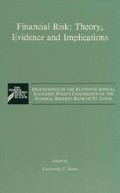Abstract
The standard models of financial markets such as the Sharpe-Lintner mean-variance model or the Rubinstein-Breeden-Litzenberger contingent consumption model both assume more-or-less homogenous probability beliefs.1 There has been some work on extending the mean-variance model to allow for differences in beliefs across agents; see Jarrow (1980), Lintner (1969), Mayshar (1983), and Williams (1977). Differences in beliefs in contingent commodities models have received much less attention. The major references are Rubinstein (1975, 1976a), Breeden and Litzenberger (1978), Hakansson et al. (1982), and Milgrom and Stokey (1982).
Access this chapter
Tax calculation will be finalised at checkout
Purchases are for personal use only
Preview
Unable to display preview. Download preview PDF.
References
Aumann, R. (1976), “Agreeing to Disagree,” Annals of Statistics, 4, 1236–1239.
Bhattacharya, S. (1976), “Information Efficiency and Inter-temporal Rates of Return,” Sloan School mimeo.
Black, F. (1986), “Noise,” Journal of Finance, 41, 529–543.
Breeden, D. (1979), “An Intertemporal Asset Pricing Model with Stochastic Consumption and Investment Opportunities,” Journal of Financial Economics, 7, 265–296.
Breeden, D. and M. Litzenberger (1978), “Prices of State-Contingent Claims Implicit in Option Prices,” Journal of Business, 51, 621–651.
Cragg, J. and B. Malkiel (1982), Expectations and the Structure of Share Prices, University of Chicago Press, Chicago.
Diamond, D. and R. Verrecchia (1981), “Informational Aggregation in a Noisy Rational Expectations Economy,” Journal of Financial Economics, 9, 221–235.
Epps, T. and M. Epps (1976), “The Stochastic Dependence of Security Price Changes and Transaction Volumes: Implications for the Mixture-of-Distribution Hypothesis,” Econometrica, 44, 305–321.
Grossman, S. (1976), “On the Efficiency of Competitive Stock Markets Where Traders Have Diverse Information,” The Journal of Finance, 31, 573–585.
Grossman, S. (1977), “The Existence of Futures Markets, Noisy Rational Expectations, and Informational Externalities,” Review of Economic Studies, 44, 431–449.
Grossman, S. (1978), “Further Results on the Informational Efficiency of Competitive Stock Markets,” Journal of Economic Theory, 18, 81–101.
Grossman, S. and R. Shiller (1982), “Consumption Correlatedness and Risk Measurement in Economies with Non-Traded Assets and Heterogeneous Information,” Journal of Financial Economics, 10, 195–210.
Grossman, S. and J. Stiglitz (1980), “On the Impossibility of Informationally Efficient Markets,” American Economic Review, 70, 393–408.
Hakansson, N., J. Kunkel, and J. Ohlson (1982), “Sufficient and Necessary Conditions for Information to have Social Value in Pure Exchange,” Journal of Finance, 37, 1169–1181.
Harris, L. (1983), “The Joint Distribution of Speculative Prices and of Daily Trading Volume,” University of Southern California Working Paper.
Harsanyi, J. (1983), “Bayesian Decision Theory, Subjective and Objective Probabilities, and Acceptance of Empirical Hypotheses,” Synthese, 57, 341–365.
Hellwig, M. (1980), “On the Aggregation of Information in Competitive Markets,” Journal of Economic Theory, 22, 477–498.
Jarrow, R. (1980), “Heterogeneous Expectations, Restrictions on Short Sales, and Equilibrium Asset Prices,” Journal of Finance, 35, 1105–1113.
Karpoff, J. (1985), “The Relationship between Stock Prices and Volume,” Center for the Study of Banking and Financial Markets Digest, University of Washington, Seattle.
Lintner, J. (1969), “The Aggregation of Investors’ Diverse Judgements and Preferences in Purely Competitive Markets,” Journal of Financial and Quantitative Analysis, 4, 347–400.
Marshall, J. (1974), “Private Incentives and Public Information,” American Economic Review, 64, 373–390.
Mayshar, J. (1983), “On Divergence of Opinion and Imperfections in Capital Markets,” American Economic Review, 73, 114–128.
Merton, R. (1980), “On Estimating the Expected Return on the Market,” Journal of Financial Economics, 8, 323–361.
Milgrom, P. and N. Stokey (1982), “Information, Trade and Common Knowledge,” Journal of Economic Theory, 26, 17–27.
Rothschild, M. and J. Stiglitz (1970), “Increasing Risk I: A Definition,” Journal of Economic Theory, 2, 225–243.
Rubinstein, M. (1975), “Security Market Efficiency in an Arrow-Debreu Economy,” American Economic Review, 65, 812–824.
Rubinstein, M. (1976a), “The Strong Case for the Generalized Logarithmic Utility Model as the Premier Model of Financial Markets,” Journal of Finance, 31, 551–571.
Rubinstein, M. (1976b), “The Valuation of Uncertain Income Streams and the Pricing of Options,” Bell Journal of Economics, 7, 407–425.
Stein, J. (1986), “Real Effects of Futures Speculation: Asymptotically Rational Expectations,” Economica, 53, 159–180.
Tauchen, G. and M. Pitts (1983), “The Price Variability-Volume Relationship on Speculative Markets,” Econometrica, 51, 485–506.
Tirole, J. (1982), “On the Possibility of Speculation Under Rational Expectations,” Econometrica, 50, 1163–1182.
Varian, H. (1984), Microeconomic Analysis, Norton, New York.
Varian, H. (1985a), “Divergence of Opinion in Complete Markets,” Journal of Finance, 40(1), 309–317.
Varian, H. (1985b), “Observable Implications of Changes in Risk Aversion,” University of Michigan Working Paper. To appear in Econometrica.
Verrecchia, R. (1981), “On the Relationship between Volume Reaction and the Consensus of Investors: Implications for Interpreting Tests of Information Content,” Journal of Accounting Research, 19, 271–283.
Williams, J. (1977), “Capital Asset Prices with Heterogeneous Beliefs,” Journal of Financial Economics, 5, 219–239.
Editor information
Editors and Affiliations
Rights and permissions
Copyright information
© 1989 Kluwer Academic Publishers
About this chapter
Cite this chapter
Varian, H.R. (1989). Differences of Opinion in Financial Markets. In: Stone, C.C. (eds) Financial Risk: Theory, Evidence and Implications. Springer, Dordrecht. https://doi.org/10.1007/978-94-009-2665-3_1
Download citation
DOI: https://doi.org/10.1007/978-94-009-2665-3_1
Publisher Name: Springer, Dordrecht
Print ISBN: 978-94-010-7701-9
Online ISBN: 978-94-009-2665-3
eBook Packages: Springer Book Archive

